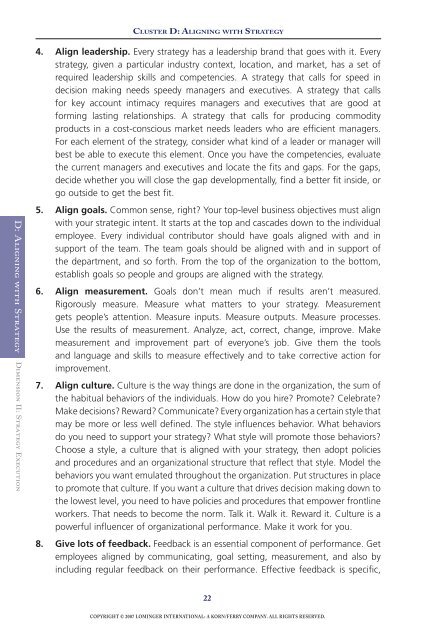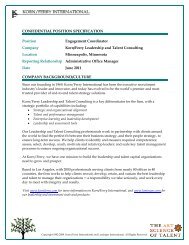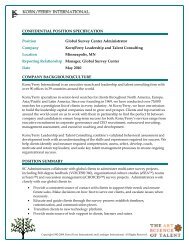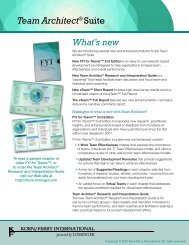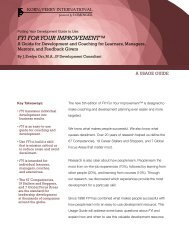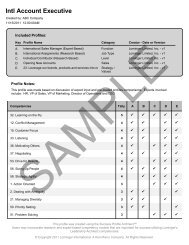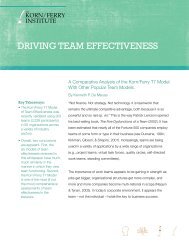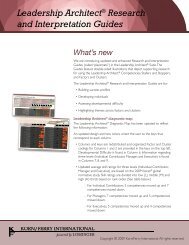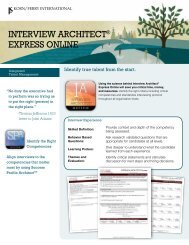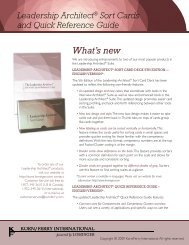for strategic effectivenessfor strategic effectiveness - Lominger
for strategic effectivenessfor strategic effectiveness - Lominger
for strategic effectivenessfor strategic effectiveness - Lominger
You also want an ePaper? Increase the reach of your titles
YUMPU automatically turns print PDFs into web optimized ePapers that Google loves.
Cl u s t e r D: Al i g n i n g w i t h St r at e g yD: Aligning with StrategyDimension II: Strategy Execution4. Align leadership. Every strategy has a leadership brand that goes with it. Everystrategy, given a particular industry context, location, and market, has a set ofrequired leadership skills and competencies. A strategy that calls <strong>for</strong> speed indecision making needs speedy managers and executives. A strategy that calls<strong>for</strong> key account intimacy requires managers and executives that are good at<strong>for</strong>ming lasting relationships. A strategy that calls <strong>for</strong> producing commodityproducts in a cost-conscious market needs leaders who are efficient managers.For each element of the strategy, consider what kind of a leader or manager willbest be able to execute this element. Once you have the competencies, evaluatethe current managers and executives and locate the fits and gaps. For the gaps,decide whether you will close the gap developmentally, find a better fit inside, orgo outside to get the best fit.5. Align goals. Common sense, right? Your top-level business objectives must alignwith your <strong>strategic</strong> intent. It starts at the top and cascades down to the individualemployee. Every individual contributor should have goals aligned with and insupport of the team. The team goals should be aligned with and in support ofthe department, and so <strong>for</strong>th. From the top of the organization to the bottom,establish goals so people and groups are aligned with the strategy.6. Align measurement. Goals don’t mean much if results aren’t measured.Rigorously measure. Measure what matters to your strategy. Measurementgets people’s attention. Measure inputs. Measure outputs. Measure processes.Use the results of measurement. Analyze, act, correct, change, improve. Makemeasurement and improvement part of everyone’s job. Give them the toolsand language and skills to measure effectively and to take corrective action <strong>for</strong>improvement.7. Align culture. Culture is the way things are done in the organization, the sum ofthe habitual behaviors of the individuals. How do you hire? Promote? Celebrate?Make decisions? Reward? Communicate? Every organization has a certain style thatmay be more or less well defined. The style influences behavior. What behaviorsdo you need to support your strategy? What style will promote those behaviors?Choose a style, a culture that is aligned with your strategy, then adopt policiesand procedures and an organizational structure that reflect that style. Model thebehaviors you want emulated throughout the organization. Put structures in placeto promote that culture. If you want a culture that drives decision making down tothe lowest level, you need to have policies and procedures that empower frontlineworkers. That needs to become the norm. Talk it. Walk it. Reward it. Culture is apowerful influencer of organizational per<strong>for</strong>mance. Make it work <strong>for</strong> you.8. Give lots of feedback. Feedback is an essential component of per<strong>for</strong>mance. Getemployees aligned by communicating, goal setting, measurement, and also byincluding regular feedback on their per<strong>for</strong>mance. Effective feedback is specific,22Copyright © 2007 <strong>Lominger</strong> International: A Korn/Ferry Company. All rights reserved.


